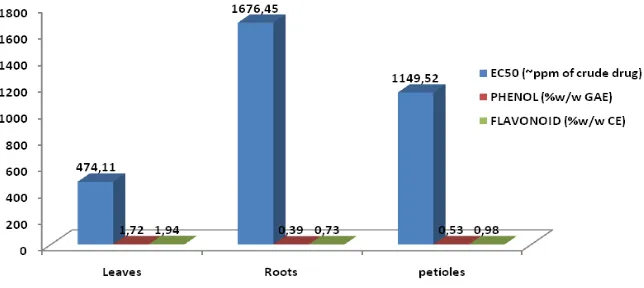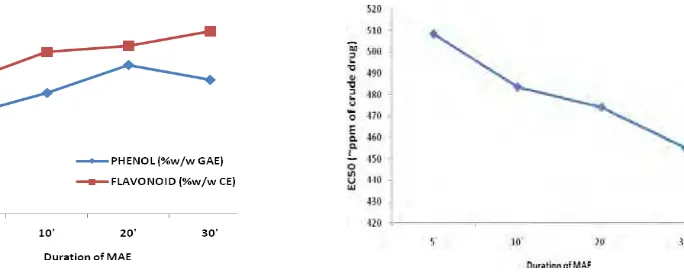21
MICROWAVE-ASSISTED EXTRACTION OF ANTIOXIDANT
COMPOUNDS FROM
PLANTAGO MAJOR
L.
Kartini*, Soediatmoko Soediman**, Dini Kesuma**, Kusuma Hendrajaya**
*Lab. Biologi Farmasi, Fak. Farmasi UBAYA **Lab. Kimia Farmasi, Fak. Farmasi UBAYA
E-mail: [email protected]; [email protected]
Abstract
A new method of microwave assisted extraction (MAE) was used to extract antioxidant compounds from
Plantago major L. Ultrasound-assisted extraction (UAE) and kinetic maceration were studied as comparison process. The effect of part of plant, duration and temperature on the free radical scavenger activity, total phenol and flavonoid content of the extract were determined. MAE was found to be the most effective method capable of yielding 1.72 %GAE total phenol, 1.94 %CE total flavonoid and giving EC50 equivalent
to474.11 ppm of crude drug with 700C and 20 min of extraction temperature and time, respectively. The
percent recovery of antioxidant compounds was found to increase with increasing MAE time and temperature. It was also found that antioxidant compounds of the leaf was much greater than that of root and petiole.
Keywords: microwave assisted extraction, total phenol, total flavonoid, antioxidant, Plantago major
INTRODUCTION
Plantago major L. (daun sendok) has been used by people in various countries for the treatment of skin diseases, infections, problems related to the digestive organs, respiratory, reproductive, circulatory, against tumors, eliminate pain and reduce fever. This herb is also reported to have antioxidant activity and free radical scavenger, although lower than in tea. In addition to 15 kinds of flavonoids, this plant also contains terpenoids, alkaloids, derivatives of caffeic acid, iridoid glycosides, polysaccharides, fats, vitamins and organic acids (Samuelsen, 2000). Flavonoids is
estimated as the main antioxidant
components from these plants. Consequently, it is important that effective methods for extracting these components from P. major be developed.
The availability of standardized plant extracts is important to commercial production. For extracts preparation, selection
of appropriate extraction method is a key consideration. Presently, a number of extraction methods including kinetic maceration, UAE and MAE are available (Zhang et al., 2005). However, comparative studies of these methods, especially for the extraction of antioxidant components from P. major have not been attempted previously.
The purpose of the present study is to examine different extraction methods for P. major and compare them relative merits. The experiments and conclusion are given in the following section.
METHODS
Material, chemical and instrumentation
Jurnal Ilmiah Sains dan Teknologi Vol.5 No.1, hal. 21-27
22
AlCl3 (Merck), NaOH (Merck), NaNO2 (Merck), Na2CO3 (Merck) and demineralized water (FF, UBAYA). Instruments including microwave oven (2450 MHz, 700 W, from Sharp), ultrasonic bath (Branson 2000), magnetic stirrer (Ceramig Midi IKA® Works), spectrophotometer (Cintra), analytical balance (Sartorius BL210s), blender (Hitachi), stopwatch (Alba), sieve (30 mesh), vortex mixer (Thermolyte), and laboratory glassware equipment.
Preparation of plant materials and kinetic maceration
Fresh herbs of P. major were harvested, washed, and separated into roots, leaves and petioles. These three parts of plant then called as “sample”. These samples then dried under indirect sunlight. Dried materials were ground to an average size of 30 mesh in diameter. The ground samples were kept in a dry place until use. A conventional solvent extraction method was used in this study: kinetic maceration. In this method, two gram of sample was extracted in 70 ml of water in a 250 ml beaker glass at room temperature using magnetic stirrer (360 rpm, 20 minutes). The extract was then filtered into a 100 ml volumetric flask. The sample residue after extraction was washed in approximately 30 ml of water, and lastly fixed with water until 100.0 ml. The antioxidant activity, concentration of total phenol and flavonoid were measured by a spectrophotometer.
UAE
For the UAE experiments, an ultrasonic bath was used as an ultrasound source. The bath was basically a rectangular container (15 cm×15 cm×15 cm), to which 47 kHz ± 6% transducer was annealed at the bottom, and the bath power rating was 270W. The extraction of antioxidant compounds were performed by adding two gram of sample into 70 ml of water in a 250 ml beaker glass. The
beaker glass was then partially immersed into the ultrasonic bath, which contains 2.2 litre of water. The bottom of the beaker glass was approximately five cm above the bottom of the bath. The solvent surface in the beaker glass was kept at the level of the water in the ultrasonic bath. Extraction was conducted for up to 20 min at room temperature. The extract was then filtered into a 100 ml volumetric flask. The sample residue after extraction was washed in approximately 30 ml of water, and lastly fixed with water until 100.0 ml. The antioxidant activity, concentration of total phenol and flavonoid were measured by a spectrophotometer.
MAE
MAE experiments were performed on a
microwave oven. The extraction of
antioxidant compounds was conducted by adding two gram of sample into 70 ml of water in beaker glass. The beaker glass were placed symmetrically in the microwave field. Experiments were carried out to determine the effect of irradiation time (5, 10, 20, 30 min) and temperature (40, 70, 1000C) on MAE efficiency. After microwave irradiation, the solution was filtered into a 100 ml volumetric flask. The sample residue after extraction was washed in approximately 30 ml of water, and lastly fixed with water until 100.0 ml. The antioxidant activity, concentration of total phenol and flavonoid were measured by a spectrophotometer.
Measurement of total phenol concentration
Jurnal Ilmiah Sains dan Teknologi Vol.5 No.1, hal. 21-27
23
Na2CO3 solution was added to the mixture and fixed with addition of water until 10.0 ml. After incubation for 15 minutes at room temperature, the absorbance against prepared reagent blank was determined at 706 nm with an UV-Vis spectrophotometer. The total phenol content of extract was expressed as gram gallic acid equivalent (GAE)/100 gram of dry weight. All samples were analysed in five times replication, each in duplicates.
Measurement of total flavonoid concentration
Total flavonoid content measured by the aluminum chloride colorimetric assay (Marinova et al., 2005). An aliquot (one ml) of extracts or standard solution of catechin (12, 15, 18, 21 and 24 mg/l) was added to 10 ml volumetric flask containing four ml of water. To the flask was added 0.3 ml 5% NaNO2. After five min, 0.3 ml 10% AlCl3 was added. At 6th min, two ml 1 M NaOH was added and the total volume was made up to 10.0 ml with water. The solution was mixed well and absorbance was measured against prepared reagent blank at 503 nm. Total flavonoid content of extract was expressed as gram catechin equivalent (CE)/100 gram of dry mass. All samples were analysed in five times replication, each in duplicates.
Antioxidant activity measurement
Antioxidant activities of P. major extracts obtained using UAE, MAE, and kinetic maceration were tested and compared by measuring the ability of the extracts to scavenge the free radical DPPH (1,1-diphenyl-2-picrylhydrazyl) invitro. The assay method was modified from that described in Wu and Ng (2008). For the purpose of comparing the antioxidant activity in various extracts, concentration of sample producing 50% reduction of the radical absorbance (EC50) was used as an index. To find this value, the extract was diluted in series with water and
1.5 ml of each diluted extract was added to 3.0 ml of 0.004% DDPH solution. The solutions were mixed using a vortex mixer and the mixture was then incubated for 10 minutes in darkness at room temperature, after which the absorbance was measured at the wavelength of 520 nm using water and ethanol as a reference. EC50 can be found from a plot of percent inhibition (PI) versus the concentration of extract. The values of PI can be calculated using the following equation:
PI (%) = (1 – At/Ar) x 100
in which At and Ar are absorbance of test sample and absorbance of the DPPH reference, respectively.
RESULTS AND DISCUSSION
Comparison of extraction methods
Jurnal Ilmiah Sains dan Teknologi Vol.5 No.1, hal. 21-27
24
induce free radicals formation within the liquid medium, causing oxidation and
degradation of the phenol, including that of flavonoid (Hemwimon, 2007).
Figure 1. EC50, total phenol and total flavonoid content in P. major extract resulted from Kinetic
Maceration (MK), UAE and MAE
Comparison of parts of plant
A certain part of the plant has higher levels of chemical compounds than those of the others. Among others, depending on how and where the metabolism of these compounds. Flavonoids are found in all part of plant including leaves, roots, wood, bark, pollen, nectar, flowers, fruit and seed. Higher concentrations are in the leaves and barks compared with other parts. There is
estimated about 2% of all carbon photosynthesized by plant or approximately 1x109 tons/year converted into flavonoids (Markham, 1988). Mostly photosynthetic process occurs in green (contain chlorophyll) leaves. Therefore, this experiment has showed the water extract of P. major leaves has higher level of total flavonoids, total phenols, and antioxidant activity than the roots and petioles (Fig. 2).
Figure 2. EC50, total phenol and total flavonoid content in P. major extract resulted from leaves, roots
Jurnal Ilmiah Sains dan Teknologi Vol.5 No.1, hal. 21-27
25
Effect of extraction temperatures
Generally, the higher extracting temperature is profitable for extraction due to the increased solubility. In a closed microwave vessel used in this study, the temperature of the solvent could be increased above the boiling point temperature. As a result, the solubility of phenol and flavonoid could greatly be enhanced. The effect of extraction temperature is shown in Fig. 3 which clearly
demonstrates that increasing the
temperature of the solvent from 40 to 1000C significantly increases the extraction
efficiency. This is because higher temperature causes intermolecular inter-actions within the solvent to decrease, giving rise to higher molecular motion, and causing the solubility to increase. The increasing temperature may also cause opening cell matrix, and as a result, phenol and flavonoid availability for extraction increases. Moreover, at high temperature, solvent viscosity decreases and the diffusivity increases, thus the efficiency of extraction increases (Pan et al., 2000; Camel, 2000).
Figure 3. Effect of extraction temperature of MAE
Effect of duration of extraction
Generally, with increasing duration of extraction, the number of dissolved compounds will increase and moreover, pharmacological activity of the extract will increase too. If the compound is thermostable or does not evaporate, with increasing duration of heat the number of compounds dissolved will increase and more until reach a state where the compounds cannot be extracted again. In such conditions, if the extraction time increased,
Jurnal Ilmiah Sains dan Teknologi Vol.5 No.1, hal. 21-27
26
Figure 4. Effect of duration of MAE
CONCLUSIONS
MAE of P. major leaves gives the highest yields of antioxidant compounds. The
appropriate condition for maximum
antioxidant components with MAE was at the extraction temperature of 100oC and extraction times of 30 min. These results demonstrate the new MAE potential to
extract the antioxidant compounds from the leaves of P. major.
ACKNOWLEDGEMENTS
The authors greatly appreciate students (Sherly, Vicky, Indah, Lita, Melda, Kristin, Sari and Melinda) for technical assistance.
REFERENCES
Camel, V. 2000. Microwave-assisted solvent extraction of environmental samples. Trends Anal. Chem., 19, pp.229–248.
Hemwimon, S., Pavasant, P., Shotipru, A. 2007. Microwave-assisted extraction of antioxidative anthraquinones from roots of Morinda citrifolia. Sep. Purif. Technol. 54, pp.44–50.
Kahkonen, M.P., Hopia, A.I., Vuorela, H.J., Rauha, J.P., Pihlaja, K., Kujala, T.S., Heinonen, M. 1999. Antioxidant activity of plant extracts containing phenolic compounds. J. Agric.Food Chem. 47, pp.395439-62.
Marinova, D., Ribarova, F., Atanassova, M. 2005. Total Phenolics and Total Flavonoids in Bulgarian Fruits and Vegetables. Journal of The University of Chemical Technology and Metallurgy, pp.255-300.
Markham, K.R. 1988. Cara mengidentifikasi flavonoid, Terjemahan Padmawinata K. Bandung: Penerbit ITB.
Jurnal Ilmiah Sains dan Teknologi Vol.5 No.1, hal. 21-27
27
Samuelsen, A.B. 2000. The Traditional Uses, Chemical Constituents and Biological Activities of Plantago major L.A Review. J. Ethnopharmacol. 71, pp.1-21.
Wu, S-J, Ng, L-T. 2008. Antioxidant and free radical scavenging activities of wild bitter melon (Momordica charantia Linn. var. Abbreviata Ser) in Taiwan. LWT. 41, pp.323-330.

